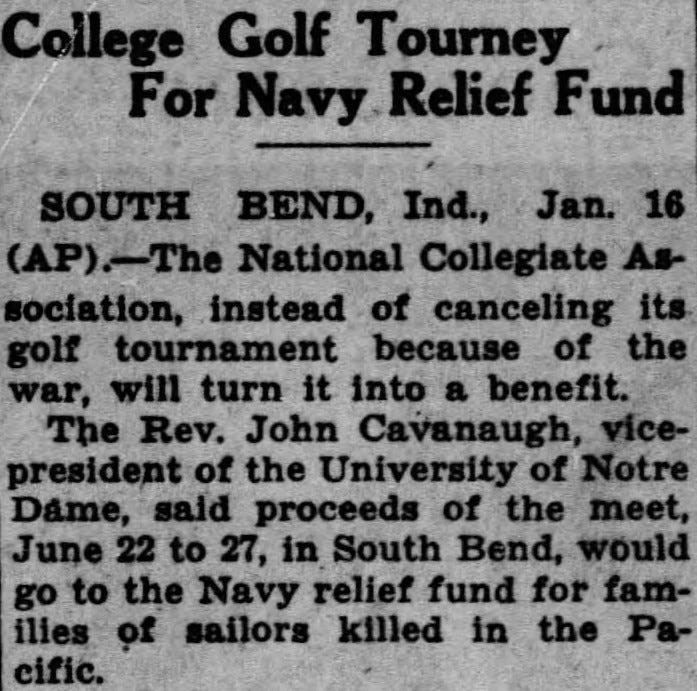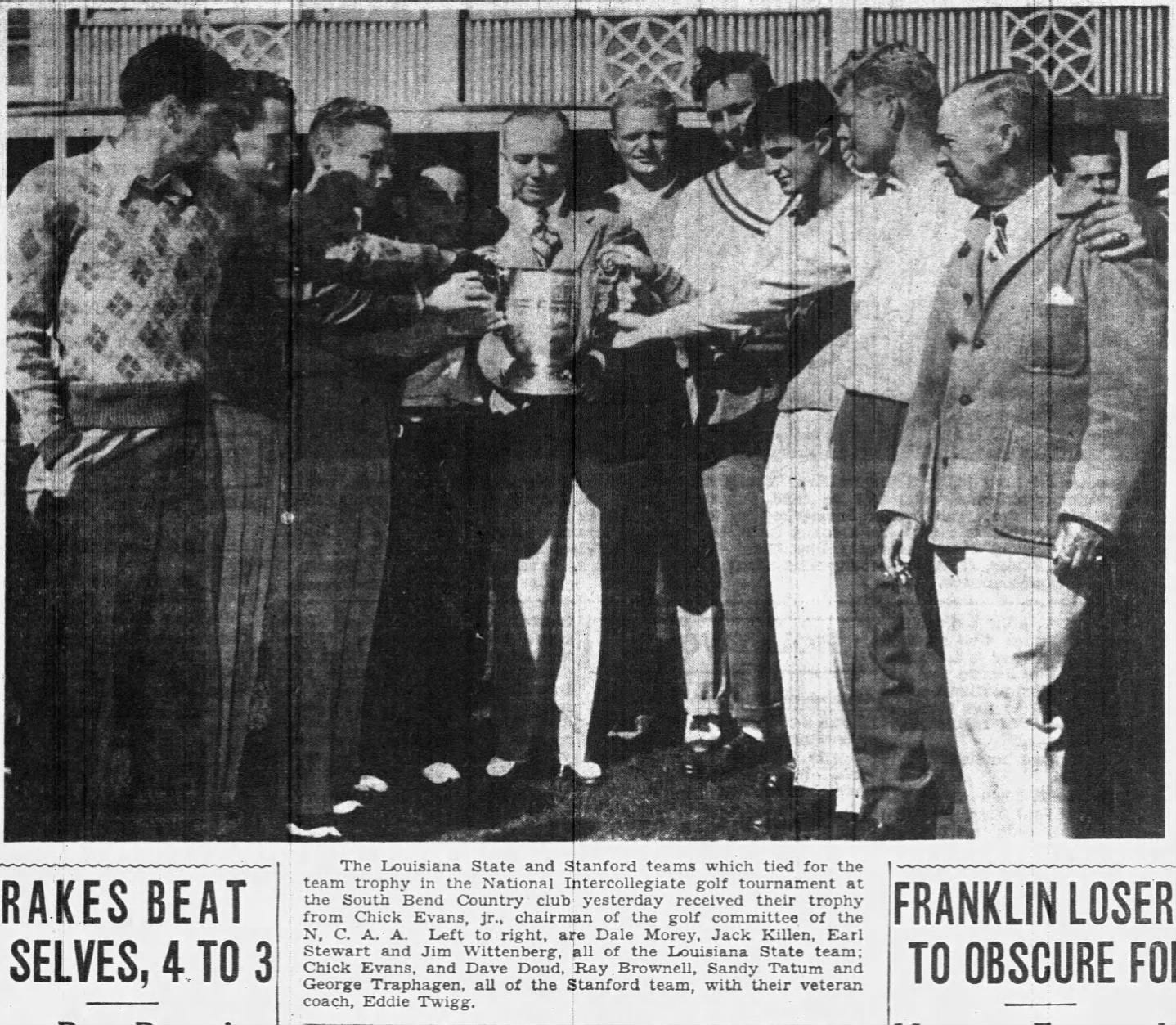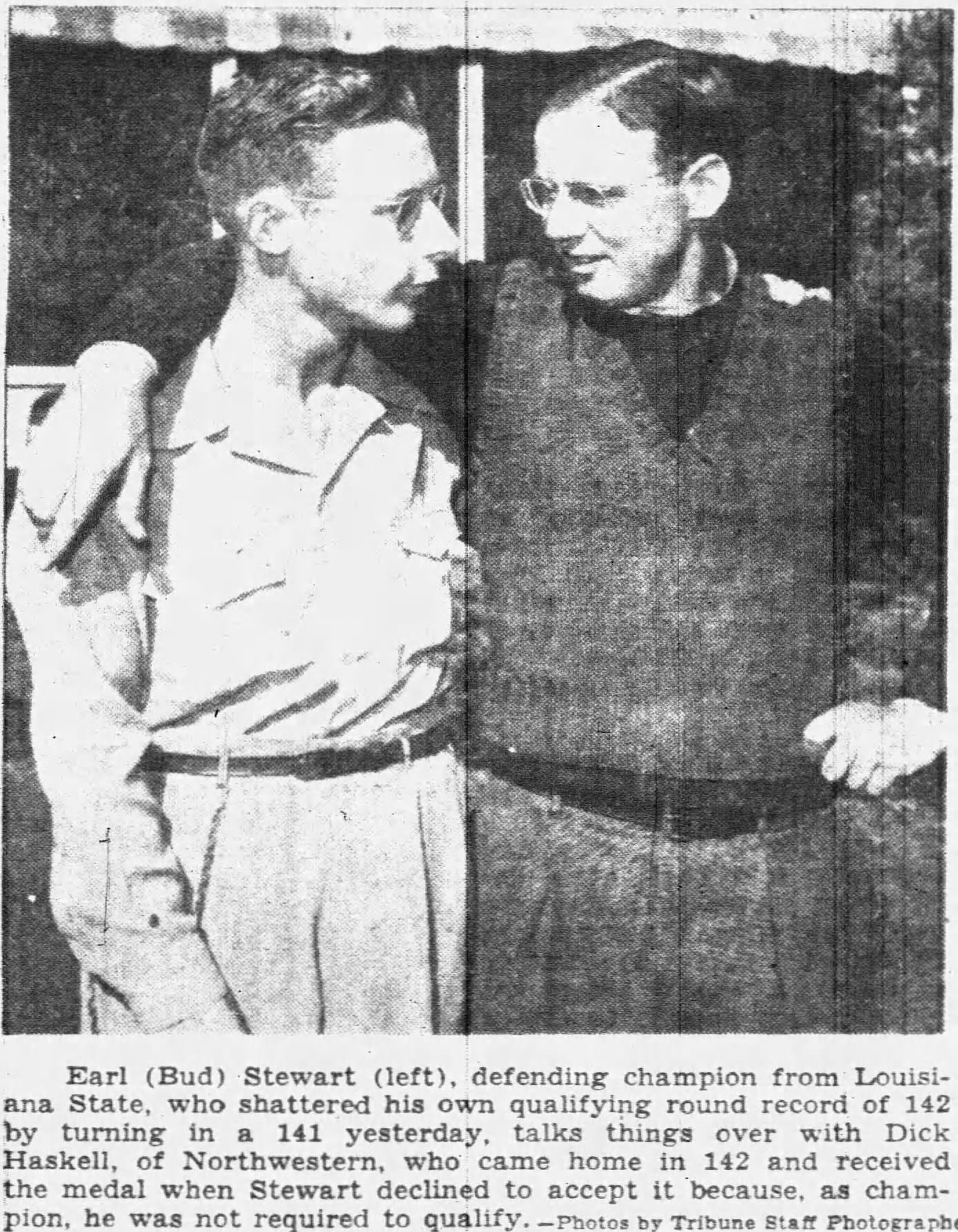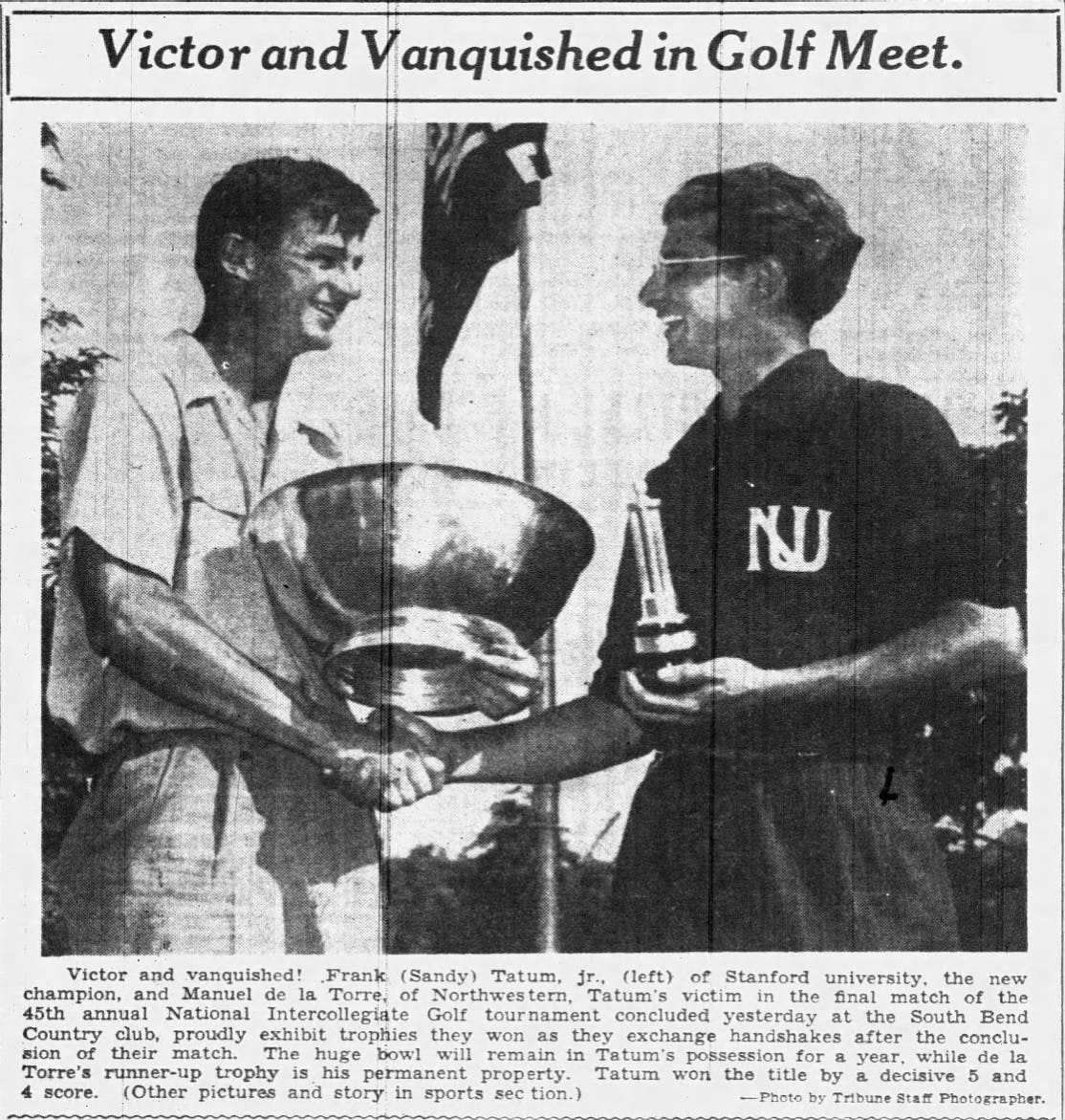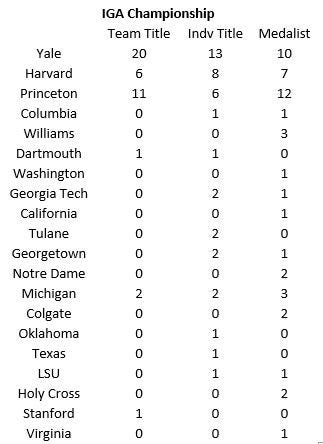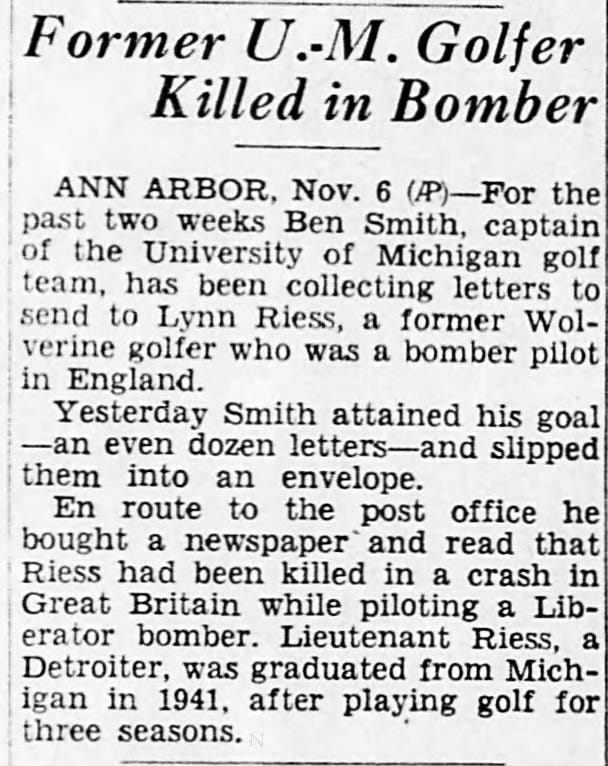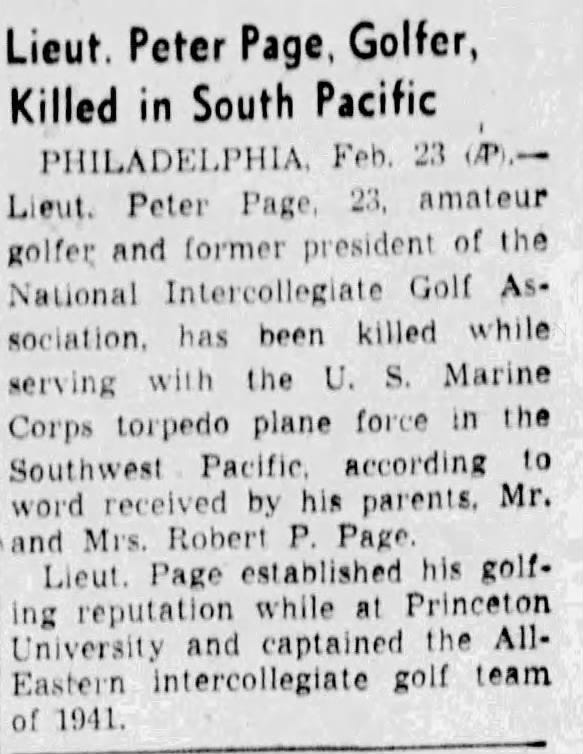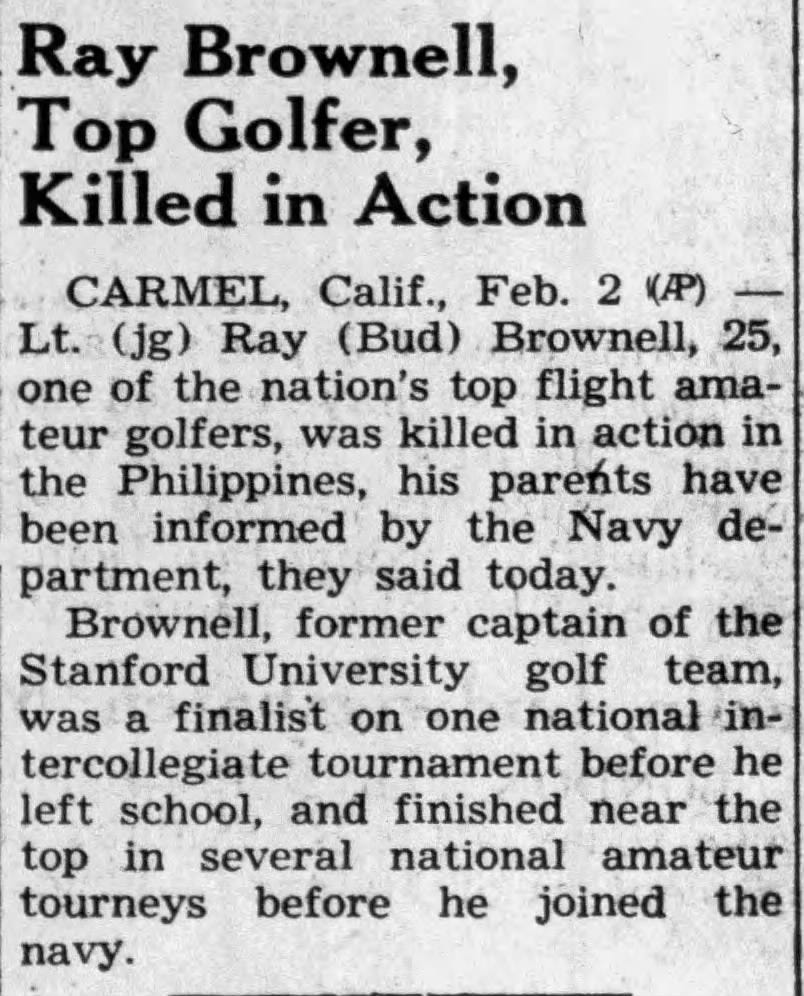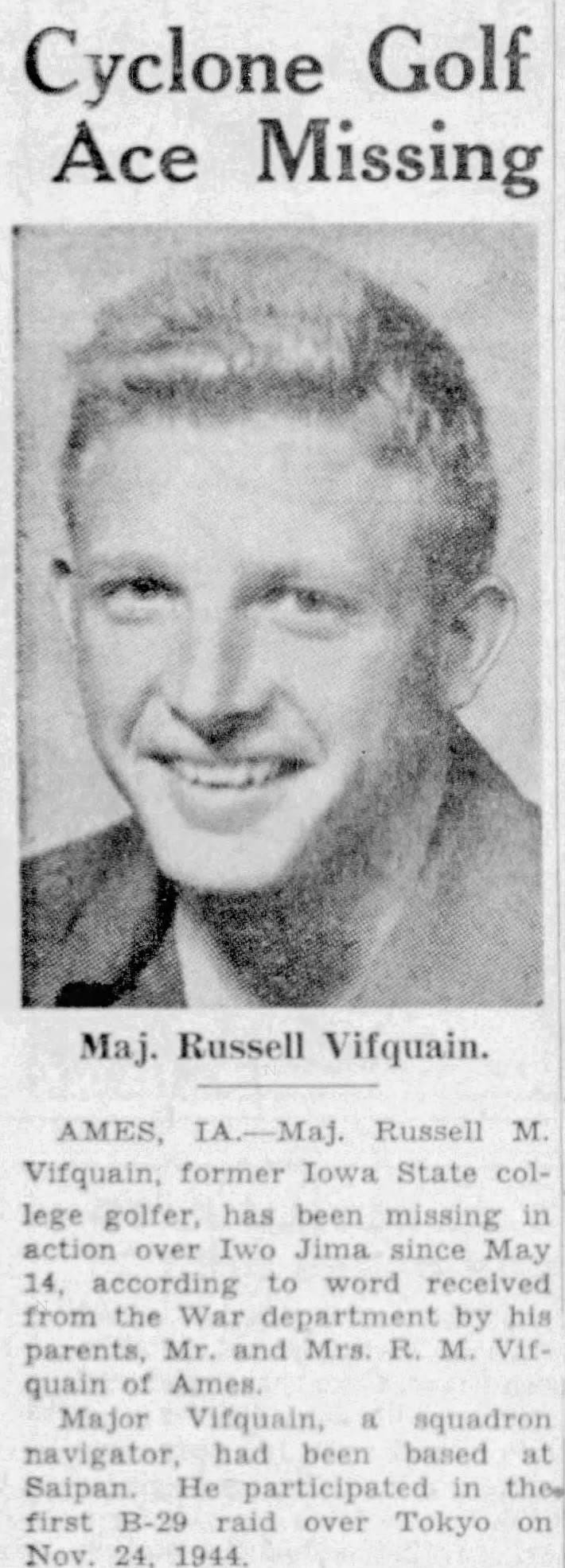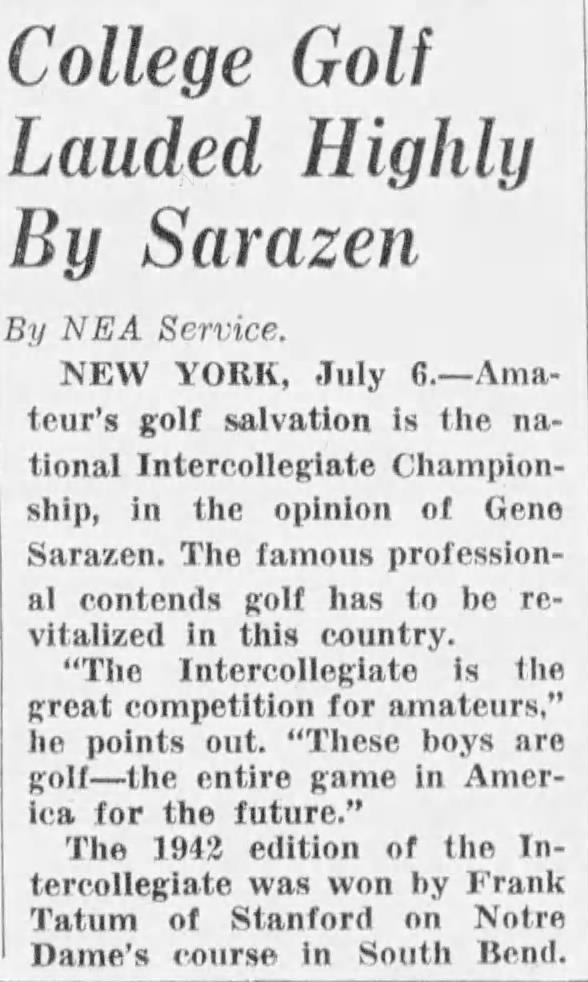This is part of a series on the Men’s Collegiate Championships
NCAA Championship Era: 1939-NOW
December 7th, 1941 changed everything, and sports were no exception. Almost immediately many of the biggest organizations, including the USGA, decided that it was not appropriate to run their annual championships, so more and more sporting events and tournaments were cancelled throughout 1942 and 1943. If the collegiate golf championships still fell under the purview of the USGA, it’s likely that the championship would have been cancelled throughout the WWII years just as it had been during WWI. Instead, the NCAA decided to continue many of their championships, including golf, for those college youths who were not (yet) actively involved in the war effort. In early January 1942, amidst the announcement of many cancellations throughout the sporting world, the NCAA in conjunction with host Notre Dame announced that the collegiate golf championship would go on as planned in June and that the proceeds for the event would be donated to the Navy Relief Fund. Appropriately, this would also be the first championship where the Naval Academy was represented as a team at the national championships.
Intercollegiate Championship #45: June 22-27, 1942
Host: South Bend CC (Chain O’Lakes course) [Notre Dame]
For the second time in as many years, the NCAA championship was hosted by a college team, this time Notre Dame had the honor. Notre Dame Hall of Fame golf coach Rev George L Holderith - acting as the (local) tournament director - organized a number of events to celebrate the tournament as well as the university’s centennial. Although Holderith’s undefeated team would not go on to win this event, their golf prowess would eventually lead to a team national championship just two years later.
Format
Team stroke play
Day 1 = 18 holes
Day 2 = 18 holes
**6-count-4, doubles as the individual qualifier
Individual match play (64 players, random draw, 18 hole matches)
NOTE: Due to the decreasing number of players and teams able to participate in the tournaments between 1943-1946, there were several interesting format differences during those years
1943 - down to just an 18 hole individual qualifier (first time since 1916) and only 32 match play qualifiers
1944 - again 18 hole SP qualifier which also determined team title, only 32 MP qualifiers
1945 - 36 hole SP qualifier but down to 16 MP slots, lowest since 1920
1946 - entire championship was SP with the first 36 holes determining team title and cut to low 40 players for remaining 36 holes to determine individual title
1947 - returned to same format as 1942
Results
Team Champ: LSU (2 NCAA, 2 overall) & Stanford (3 NCAA, 4 overall)
Ray “Bud” Brownell had a 6-foot putt on the last green to give Stanford another championship, their second in a row and third since 1939. The miss dropped Stanford from the solo lead down into a tie with LSU - who was the runner-up to Stanford in 1941 - with a 4-man team total of 590. Instead of a playoff for the championship, tournament officials went with the same ruling as the 1940 championship where LSU and Princeton shared the team title, each keeping the Maxwell Cup for six months. So for the second time in NCAA’s short tenure, two teams were crowned as the winner at the end of play. It would be another 53 years before another tie would happen (1995), and by then a playoff policy was put in place. Along with the accomplishments listed above for Stanford being true, LSU also got to celebrate their second championship in three years (both shared) with a runner-up finish in between.
It’s worth noting that both NCAA championship teams were also conference winners - LSU won their 5th SEC championship (in the 6 years of the conference championship history) while Stanford won the Pacific Coast Conference Southern title thanks in large part to captain Frank “Sandy” Tatum who took home medalist honors and teammate Frank McCann who won the individual match play title.
Medalist: *Dick Haskell [Northwestern]
Golf is a very straightforward game, put the ball in the hole in the fewest amount of strokes and you win. So when reigning NCAA champion (and medalist) Earl “Red” Stewart [LSU] holed out his 141st stroke of the 36 hole qualifying portion of the championship, it seemed pretty clear that not only had he repeated as medalist he also had beaten his own record from the previous year (142). Things got very confusing, however, when he told tournament officials that he was refusing medalist honors and that instead they should go to Northwestern’s Richard “Dick” Haskell. You see, as long as individual match play has been a part of the collegiate golf championship, there had been a seldom-exercised exemption for the reigning champ to automatically qualify for the match play portion without having to go through qualifying. Once team match play was dropped in favor of a combined team SP and individual qualifying (right after WWI), that player could still participate in the stroke play portion and have their score count towards the team total without needing to worry about that score being good enough to qualify them for the individual match play portion. As the 1941 champion, Stewart announced he was using this option so that medalist honors would instead pass to another deserving player who had equaled his record low qualifying total. Despite this act of sportsmanship being almost universally applauded, it left tournament officials in an awkward position when it came to addressing the fact that Stewart had technically set a new record low total. Newspaper accounts of the time indicate officials declared that the new record of 141 would stand, however the NCAA record book does not reflect this (although to be fair we’re not sure exactly how they would given the format of the book). Regardless, Haskell is proudly listed in the NCAA record book as the 1942 medalist, just three names away from another Northwestern man, 1939 medalist Sid Richardson.
The 1942 championship was the last one run by NCAA Golf Committee Chairman Chick Evans before handing off responsibility to Pitt’s James Hagan (a post he held throughout the WWII championships). One cool fact is that Richard Haskell was another Evans Scholar, meaning that medalists from both his first (1939) and last NCAA championships were attending Northwestern thanks to Evans.
Individual Champ: Frank “Sandy” Tatum [Stanford]
Fittingly, the 1942 individual championship match play bracket brought together perhaps the most diverse group of semifinalists yet seen with: Manuel de la Torre [Northwestern] born in Spain versus Bob Kuntz [Yale] born in New York to German parents, and Harold Gjolme [Washington] born in Seattle to Norwegian parents versus Frank Tatum [Stanford] born in California to Scottish parents. De la Torre’s win made him the first player born in another country to reach the match play finals. Although the Finals score finished as 5&4 in favor of Tatum over de la Torre, the latter was said to have played marvelous golf. Notre Dame’s newspaper coverage of the event reported Tatum’s coach Eddie Twiggs choking up over his captain’s victory, obviously incredibly happy for the man who helped organized the fund raising that allowed Stanford to make the trip to the tournament where they would ultimately collect both the team and individual titles, the only time in Twigg’s illustrious coaching career that would happen.
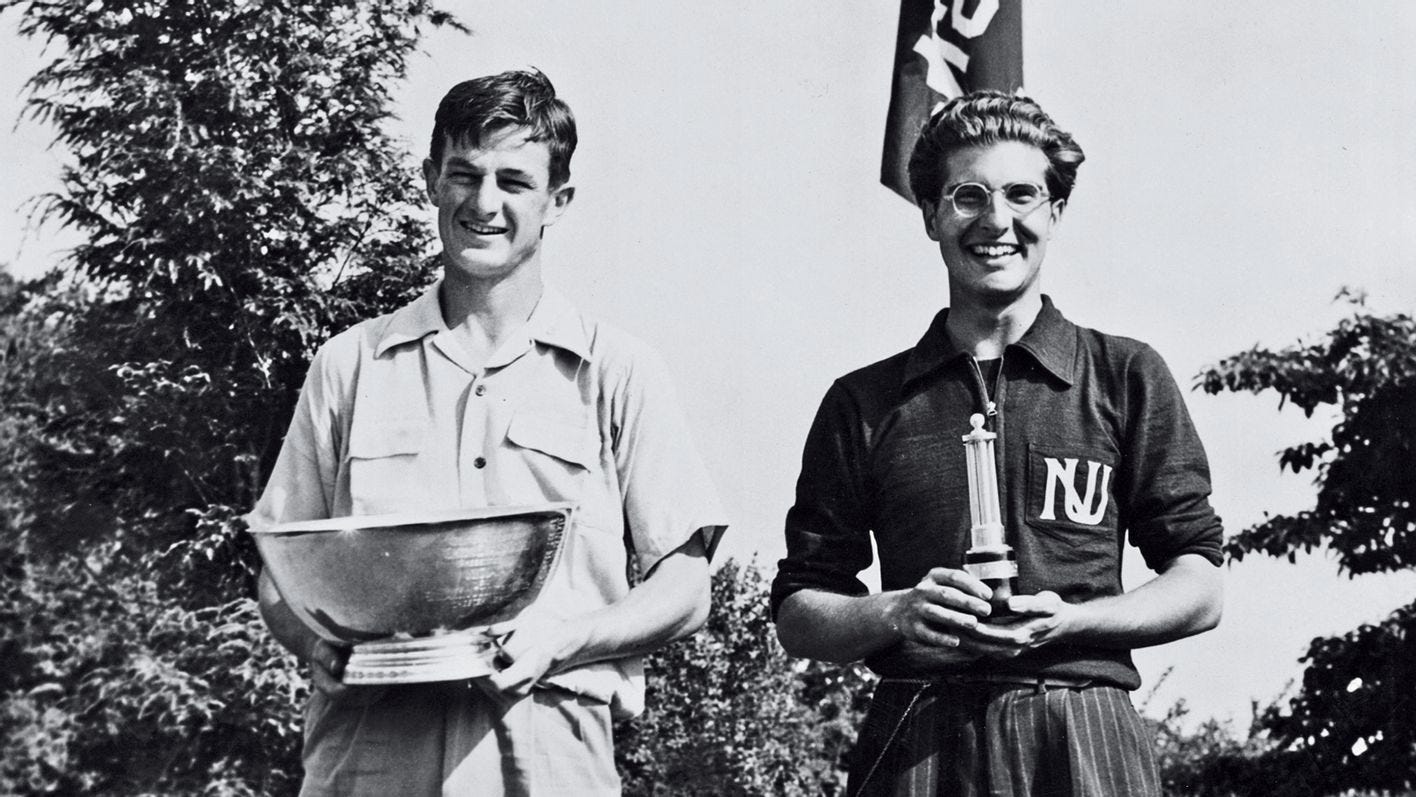
Both of these men would serve the United States - Tatum joined the Navy while de la Torre was eventually able to join the Army - and live incredibly successful lives after the war. Tatum would become a Rhodes Scholar in 1947, played for the Oxford team, and enjoyed many successful ventures in golf including a stint as the USGA President in 1978-79. Manuel de la Torre, who was not yet a full US citizen at the time of his (attempted) enlistment in the Army shortly following the 1942 championship, ended up taking a longer route into the armed forces by having to be drafted then granted citizenship in 1943. His war efforts eventually brought him to the beaches of Normandy and through France and into Germany, where he served honorably in an anti-aircraft battery. De la Torre returned to Northwestern following the war, and captained the 1946 and 1947 golf teams before joining the professional ranks. Today, Manuel de la Torre is remembered as one of the greatest PGA golf teachers ever, having earned the first PGA Teacher of the Year Award in 1986 and in 2005 becoming just the 12th member of the World Golf Teachers Hall of Fame.
Championship Award Count
EXTRA HOLES: College Golf Goes To War (Again)
Among the millions of people who fought for the United States during World War II (and even a handful who fought against the US) were many people involved in some notable way with college golf, and each one has a story worth telling. We hope to go more in depth into the lives and accomplishments of these and many more individuals at another time and in another format. For now, the best that we can do is highlight the actions of some of the people known in the college golf world as an example of the bravery seen throughout the country. We really cannot properly express our reverence for the men and women who fought, died, and/or generally did the best they could during this incredible time of war.
James Chase Fannon [Northwestern]
1939 Big Ten champion who may have been the first casualty in the college golf world
His plane went down into the Missouri River during training in June 1942
Sid Richardson [Northwestern]
1937 & 1938 Big Ten champion, 1939 NCAA medalist
Served overseas as an executive officer of a troop transport that participated in the first landings on both Iwo Jima and Okinawa
Returned to Northwestern as the golf coach in 1946, a position he held for the next 30 years
Lynn Riess [Michigan]
Graduated in 1941 and was still close with many of the players on the 1942 team
KIA November, 1942
John Burke [Georgetown]
1938 IGA individual champion (the last before the NCAA took over)
Was killed by friendly fire while serving in North Africa in 1943
His bunkmate accidently discharged a weapon while cleaning it, the bullet entering Burke’s spine
Burke died during the operation to remove the bullet
Peter Page [Princeton]
Recent Princeton captain and graduate who also served for a time as the IGA President
KIA in February 1943 when his torpedo plane crashed somewhere in the Southwest Pacific
Robert Blaylock [Iowa]
former Iowa player who was KIA May, 1944
George Sharpe [LSU]
former LSU player who was KIA during the invasion of Southern France in 1944
Billy Swan [Penn State]
former Penn State player who was KIA in Nov, 1944
Ray “Bud” Brownell [Stanford]
Recent Stanford graduate and eventual athletic hall of famer
Was a member of the 1941 and 1942 championship teams
1941 NCAA individual runner-up
KIA in the Pacific in late January 1945
Stuart Hawley [Stanford]
former Stanford player who was KIA in May, 1945
Russell Vifquain Jr [Iowa State]
former Iowa State player who was the highest-finishing player for Iowa State in the 1939 championship, qualifying for match play
Warren Berl [Stanford]
Served as a Lieutenant in the US Navy on two different ships, one of which sank in Guadalcanal
Survived the war and went on to have a successful business career
Willie Turnesa [Holy Cross]
the 1937 and 1938 intercollegiate medalist
Enlisted in the Navy which was a “curious choice for a man who was terrified of the water and had never learned to swim.”
Sent to gunnery school at the Naval Air Station in Hollywood, FL where he spent a fair amount of time golfing with superior officers and teaching sailors how to play
Fumitaka “Butch” Konoe/Konoye [Princeton]
1938 Princeton team captain who was the son of Japanese Prime Minister Fuminaro Konoe/Konoye, which technically made “Butch” a Prince
Was brought into the Japanese army in 1940 and sent to China
Survived WWII but was captured by the Soviet forces in 1945 and was kept prisoner until his death in 1956
Several more players would serve and then return to college golf afterwards, some even winning championships such as Dave Barclay [Michigan] who was the 1947 individual champion after a four-year stretch in the Army. Others not already listed include (but are certainly not limited to): James Whittenberg who was a member of the 1942 co-champion LSU team and captained the team to their first solo team title in 1947, Tom Champman [Iowa], Leo Gaulocher [Iowa], and John Jacobs [Iowa] who won the 1946 Big Ten championship.
Thanks for reading!
Up Next:
In the next post we will cover the North Texas State era, which started with the 1949 championship. Also, a familiar name from Wake Forest wins medalist honors.




